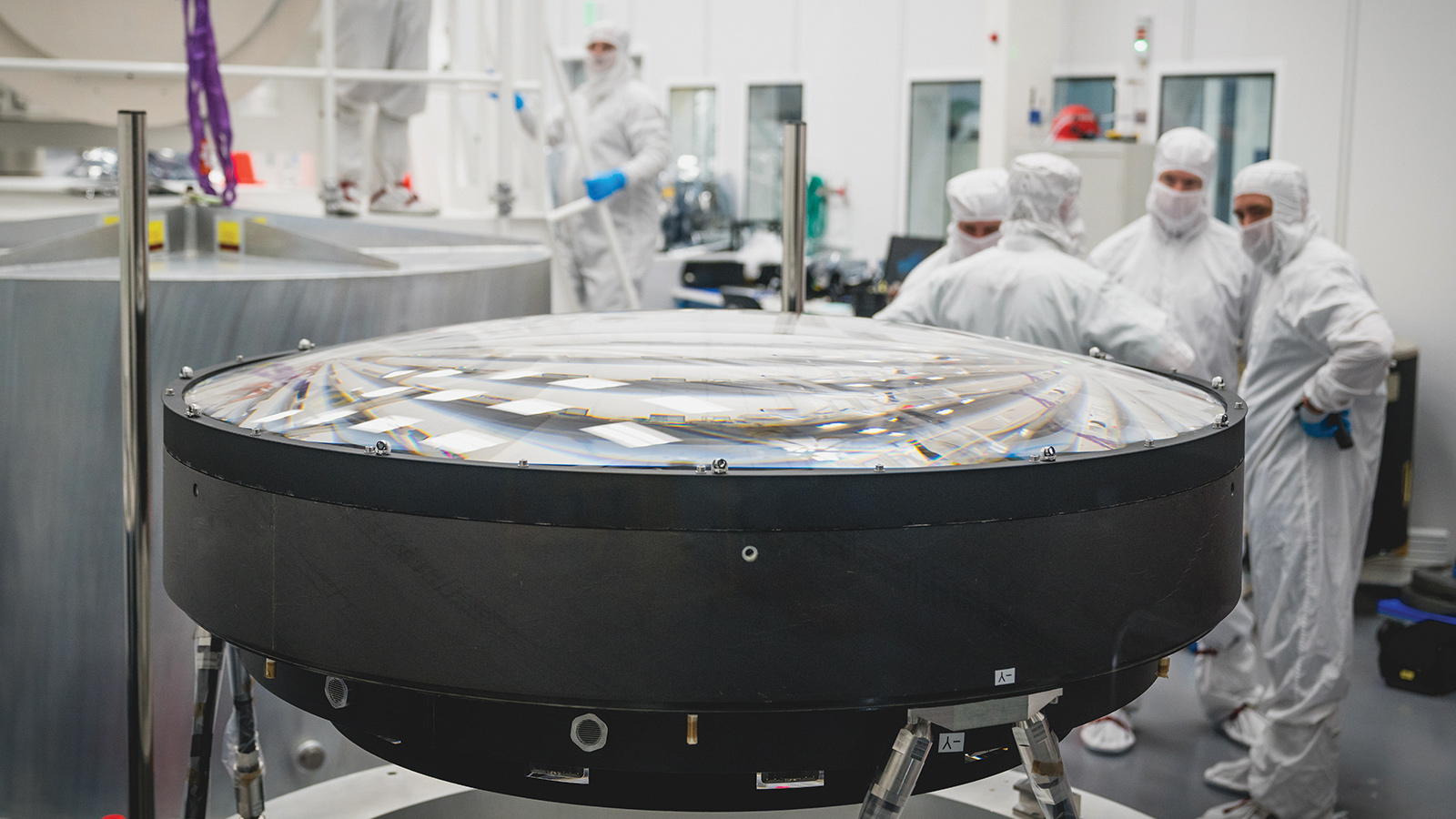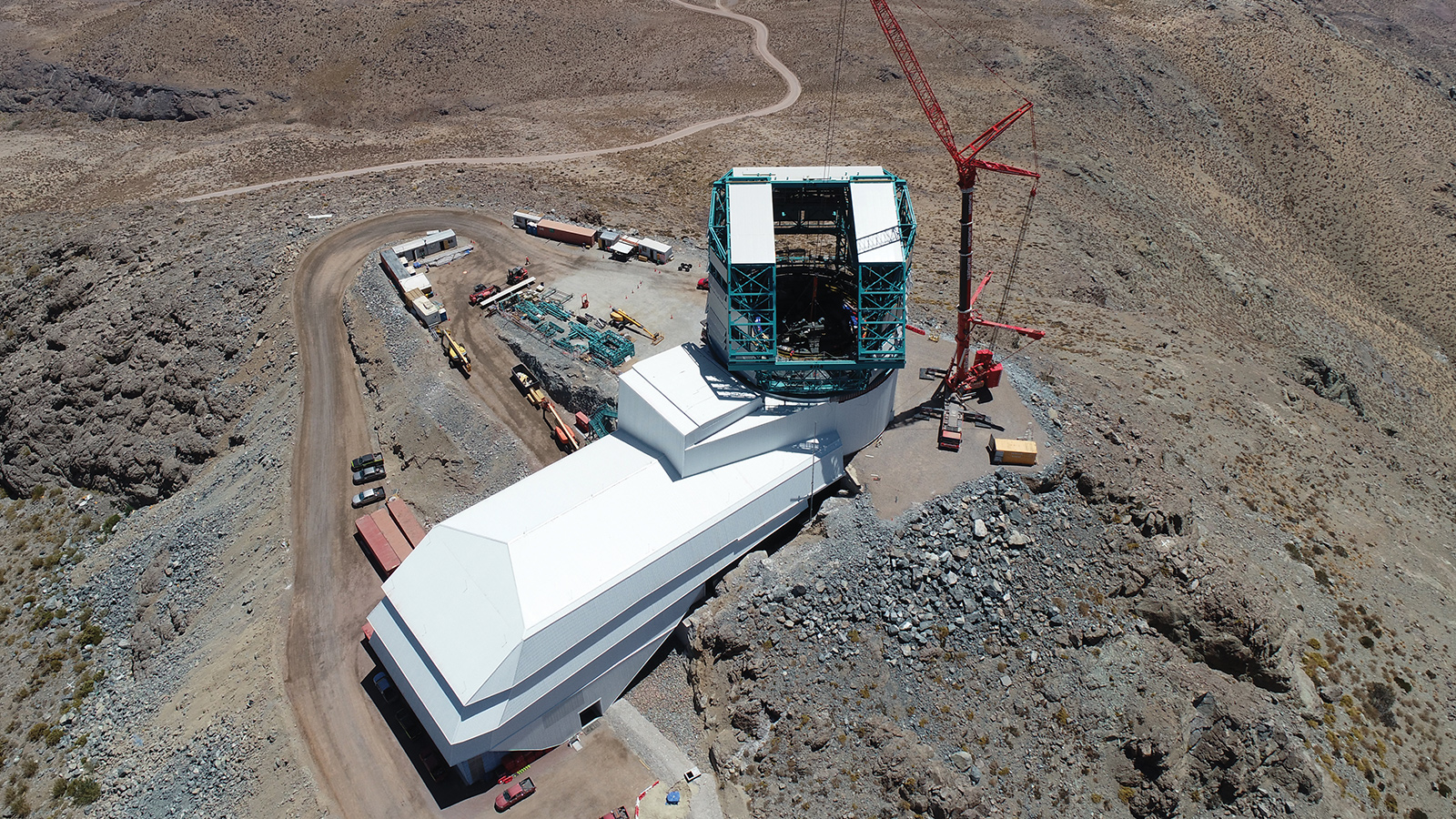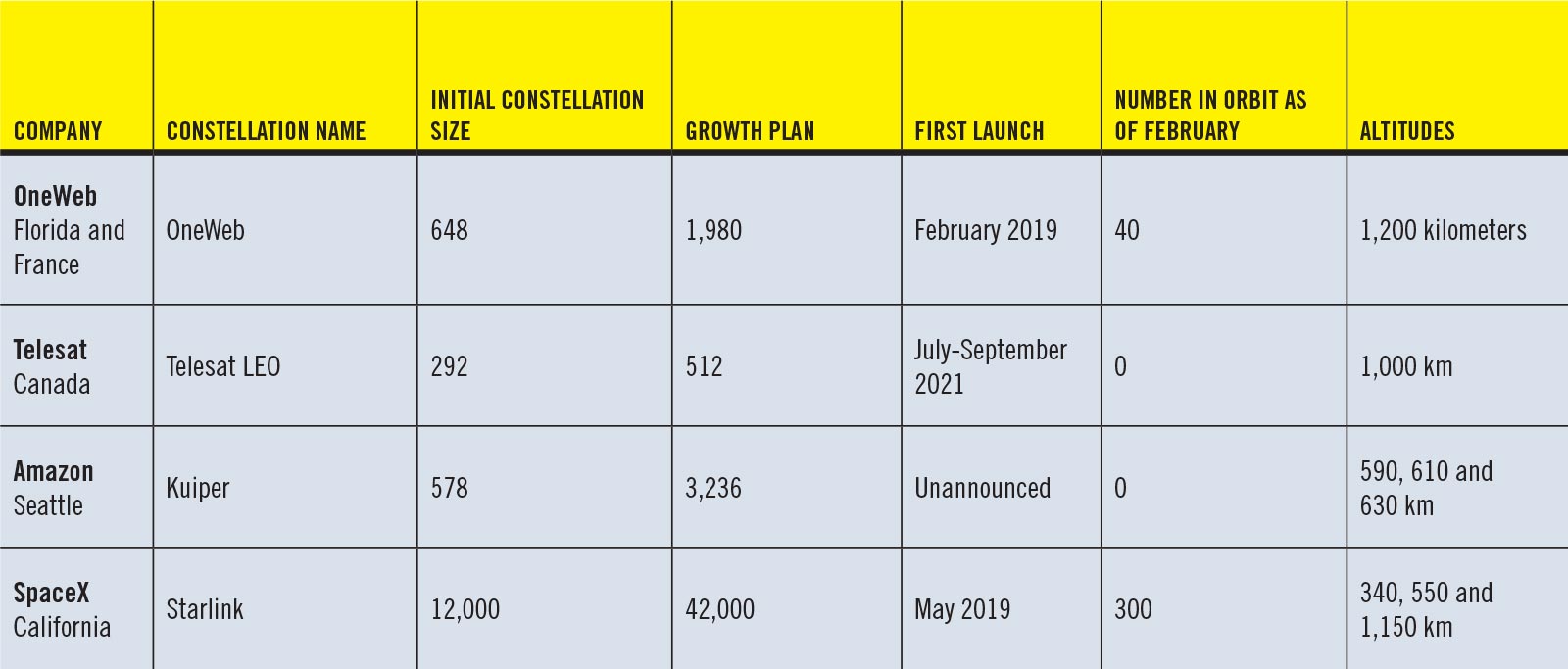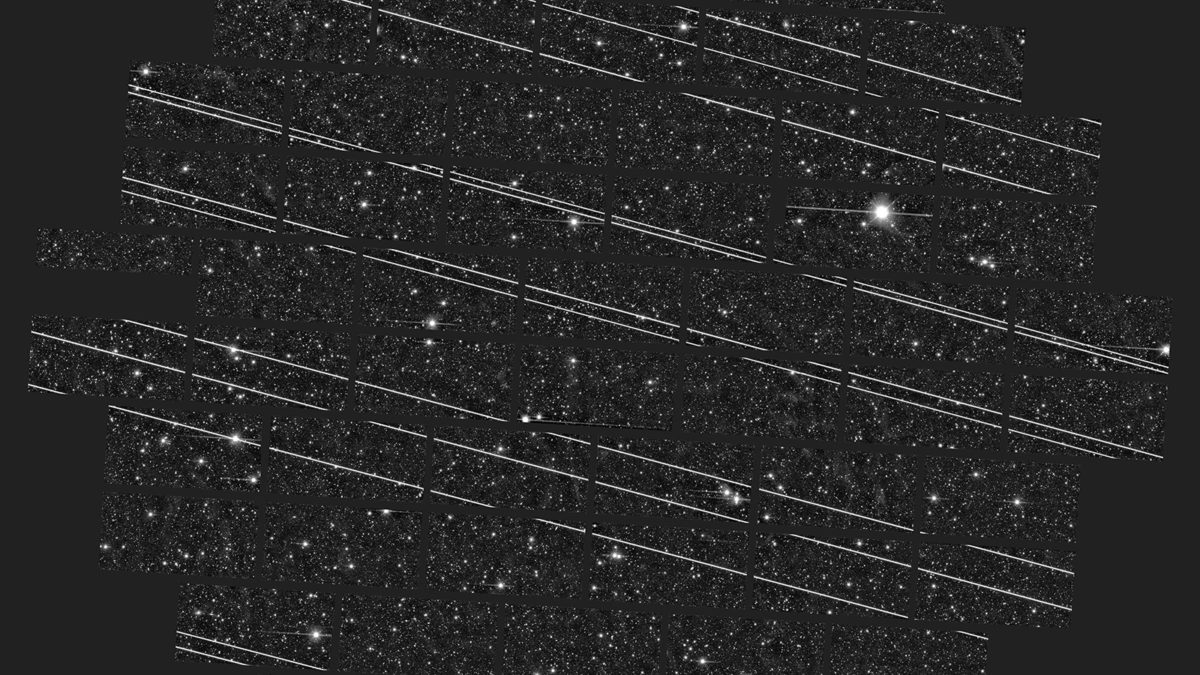Megaconstellations, mega trouble
By Adam Hadhazy|March 2020
Sending hundreds or thousands of satellites into low-Earth orbit looked like a harmless and lucrative way to target broadband internet services to societies that lack them. Then came the first launches by megaconstellation pioneer SpaceX. Adam Hadhazy assesses the surprising collateral damage to astronomy and what might be done about it.
Like other observational astronomers, Cliff Johnson has shrugged off those rare times when a photobombing satellite has ruined a telescopic image. Johnson could not so easily dismiss what he saw in the wee hours of Nov. 18, 2019. In a room at Fermilab outside Chicago, Johnson had just received real-time observations from a mountaintop telescope in Chile some 8,000 kilometers away. Numerous bright, parallel lines of light sullied the expected pristine views of the Magellanic Cloud galaxies. “Nineteen streaks across a single exposure is pretty incredible,” says Johnson, a postdoctoral fellow at Northwestern University. “That’s got to be some kind of record.”
Johnson was describing his encounter with a batch of 60 Starlink satellites launched just a week earlier by Elon Musk’s SpaceX company. Over the course of five Starlink launches since last May, casual observers have reported the streaks as UFOs and astronomers have challenged satellite engineers to help identify technical solutions to a threat to their science.
Astronomers count on long exposure times to gather the rare, valuable photons that have reached Earth from distances of millions of kilometers for solar system objects to quadrillions of kilometers for galaxies beyond our own. During these exposures, light reflected by satellites can saturate telescope picture elements, rendering these pixels useless for astronomical observations. The resulting streaks of light can mar or hide faint objects of interest or stand in as bogus data. Adding to the problem, “ghost” light can linger in the saturated pixel well past the time an offending satellite has passed out of view, affecting later observations and overall jeopardizing a significant percentage of a night’s observing time.
“Even if it’s just a few percent [of telescope observations] lost, that could be the difference between getting your science or not,” Johnson says.
Astronomers are bracing for the problem to get worse as SpaceX and its competitors race to loft megaconstellations of hundreds or thousands of satellites. A mere fraction of the total number of proposed satellites has been launched thus far, and astronomers worry that some might reflect light as the current Starlink satellites do. All in all, the planned activity represents a dramatic rise from the 1,500 or so satellites currently occupying low-Earth orbit. It’s all part of a gold rush of sorts to sell broadband internet connections to an estimated 3 billion people who have never had them.
Low-Earth orbit — which arbitrarily extends to 2,000 kilometers (1,200 miles) — is an attractive destination for these constellations, because LEO satellites orbit at least 18 times closer to internet users than geostationary satellites, depending on the precise orbit chosen. Bits and bytes won’t need to travel as far, which means websites and search results will load faster. But for astronomers, low altitude also means that significant sunlight could be bounced toward the Earth from the satellite bus, which is typically made of metal alloys, as well as the satellite’s large, flat solar panels and smack dab onto telescopes’ mirrors.
Starlinks’ light pollution caught astronomers by surprise. “Until we saw the first 120 satellites go up, this was not in the forefront of people’s minds,” says Johnson, referring to SpaceX’s hackle-raising first two launches.
The scale of the potential change in the night sky is profound, both for astronomers and casual observers. Prior to the Starlink launches, there were about 200 objects in Earth’s orbit visible to the naked eye, says Patrick Seitzer, an astronomer at the University of Michigan and a member of a committee convened by the American Astronomical Society in Washington, D.C., to consult with SpaceX and rival OneWeb about the impact of their constellations. Visible satellites can be a problem for astronomers, but long exposure times mean that even objects that can’t be seen by the naked eye can be an issue. The problem is about to get a lot worse. With five Starlink launches in the books as of February, and at 60 satellites a pop, the total has more than doubled, and if the schedule holds, the total will skyrocket to nearly 1,600 objects by the end of 2020. The brightness of the satellites diminishes as they ascend to their operational orbits, making them less of a problem for astronomers, while naked-eye sightings continue. The luminous train Johnson witnessed were Starlinks that had just been released at a low altitude of 290 kilometers. Once cleared for service by SpaceX, they will ascend to their operational altitudes of at least 500 kilometers. Also, satellites aren’t visible in the night sky unless they are at an altitude that keeps them outside of the cone of Earth’s shadow and they are reflecting toward Earth. This is why satellites catch a lot of sunbeams in the hours after the sun sets and before it rises — so much so that the orbiting machines could shine brighter than all but 170 or so stars in the night sky, according to a recent paper by Italian astronomers.
“If the LEO sat operators fail to darken their satellites, the sky is going to be forever different. It will be swarming,” says Anthony Tyson, an astronomer at the University of California, Davis.
Pushing back — gently
As their starting point, astronomers suspect that few authorities would choose the night sky over the gains in education, health care and economic opportunity that could come with the internet.
“People believe now that internet access is a human right, like food and water,” says Whitney Lohmeyer, an assistant professor at the Olin College of Engineering and a former engineer at OneWeb, the London and Virginia company that plans to erect an initial constellation of 648 internet satellites.
Also, the sunk costs in the megaconstellations are enormous. SpaceX has publicly estimated the cost of establishing its decadelong Starlink constellation at $10 billion.
As for legal recourse, even if there were a passage in international space law that could be seized, the pace of satellite launches by SpaceX, OneWeb and soon others mean that any outcome in the astronomer’s favor would likely come too late.
So, the astronomers have chosen to appeal to the megaconstellation operators to be good stewards of the sky.
The strategy might be working. A search has begun for solutions.
Collaborating
Since after the first Starlink launch, last May, Tyson has had a team working with SpaceX on identifying ways to implement a satellite-darkening technique, the first trial satellite of which launched with the third Starlink batch in January 2020. “If we can darken these things by a factor of 100, that should be sufficient,” he cautions. More realistic might be 10-20 times darker, which “would allow us to mitigate most of the science impact via massively increased data processing as well as data analysis challenges that the science community will have to deal with,” Tysons says.
As astronomers go, no one has more to lose than him. He is chief scientist for the Vera C. Rubin Observatory (formerly the Large Synoptic Survey Telescope) that’s being constructed in the foothills of the Andes Mountains in Chile. When the observatory begins operating in 2022, its telescope will feed light to the biggest digital camera ever constructed, creating movies of the entire sky every three nights. Anything and everything that shines will be captured, including potentially unknown, short-lived astrophysical phenomena.
The observatory’s designers were braced for some satellite streaking, but they figured they could cope with it through image processing, when necessary. Then with the rise of Starlink, a shock came when the astronomers began running simulations. The ballpark results for a full constellation of 12,000 Starlink satellites suggested that 200 of them would be visible to the telescope at any given time. Not every satellite would necessarily show up on the Rubin’s camera, depending upon the season and the time of night and thus the amount of potential sunlight that could be reflected back down to Earth. But still, likely a few tens of percent of images would be affected, with their data potentially spoiled. If SpaceX decided to expand its constellation to its upward limit of 42,000 satellites, and other companies launched their own megaconstellations, Tyson says estimates suggest upward of 70% of the Rubin’s observations would be lost.
One reason the satellite streaks would be so damaging is because they could masquerade as luminous arcs naturally created by foreground galactic clusters when their gravity bends and magnifies the light of farther-off clusters. Cataloging these arcs allows scientists to gauge the amounts of invisible dark matter in galaxy clusters, because dark matter’s mass contributes to the overall lensing effect. Studying the distribution of dark matter in this way is also a fundamental tool for measuring the effects of dark energy, an even more baffling entity that seems to be accelerating the universe’s rate of expansion over the course of cosmic history. Perhaps more pertinently for non-astronomy enthusiasts, droves of satellites would also make it difficult to spot sizable, city-killer asteroids that could someday collide with Earth, and which are best viewed during the so-called astronomical twilight, after the sun sets and before it rises, exactly when satellites would be brightest, too.
The SpaceX darkening technology could sharply reduce reflectance on certain Earth-facing places on the satellite bus. Per a nondisclosure agreement, Tyson cannot say more than that. SpaceX declined an interview request, pointing instead to past statements that the company is now working with astronomers.
One thing Tyson can say is that SpaceX is going beyond the conventional technique of painting a satellite black with a polyurethane called Aeroglaze Z306. This method leaves a flat black finish that still reflects about 3.5% of incident light.
A perhaps ideal solution, in terms of exquisite darkness with near-zero reflectivity, would be carbon nanotubes. “That’s glorious stuff,” Tyson says. The problem is, carbon nanotube coatings are fragile. They flake right off from basic handling and would likely be damaged in the faring during launch and deployment. “I don’t think we can use that stuff on satellites,” says Tyson, “but I may be wrong.”
Not dark, but smart
Of course, darkening agents can’t be applied to solar arrays.
To cope with the glint from these components, the Ottawa-based company Telesat has drawn a lesson from the 66-satellite Iridium constellation completed in 1998, which was the megaconstellation of its day.
These satellites famously generated brief flashes, dubbed Iridium flares, when sunlight struck their solar arrays or their door-sized antennas at certain times of night.
Iridium flares turn out to be avoidable, says Erwin Hudson, a vice president at Ottawa-based Telesat who is in charge of rolling out the company’s proposed network. “We orient the satellites in orbit so that the solar panels, which are the biggest, flattest surface on the spacecraft, are always pointed to the sun,” says Hudson. “And we actually steer the satellite through its orbit in such a way that tries to keep all the reflective surfaces either pointed to the sun, or pointed in a way such that any glint from the sun would get reflected out into space and not down to the Earth.”
Hudson says his companies and others are, in fact, trying to be good stewards of the night sky.
“The whole industry is very aware that we need to protect optical astronomy, we need to protect radio astronomy, and we need to do all the other things that it takes so that we can all share this resource of orbits and spectrum,” Hudson says. “We have built in all these good-citizen features from the very beginning of our design.”
OneWeb, meanwhile, has just begun its launch campaign, having deployed 34 satellites in February after an initial launch in 2019 of six satellites that the company says are performing well. As of press time, this deployment had not triggered the kind of naked-eye sightings and telescope photobombings around the world as Starlink’s had. Compared to SpaceX’s Starlink, OneWeb believes its smaller satellite sizes, far lower overall constellation numbers, and higher orbital altitudes will be less of a problem to ground-based astronomy. A key enabler for this potentially less-impactful megaconstellation architecture is that the company has secured advantageous radio spectrum rights, permitting transmission on higher, more-data-loaded frequencies. More data per unit of time translates to fast-enough internet speeds, even when placing fewer satellites in higher orbits, closer to what is termed medium-Earth orbit, or MEO. “Our satellites are higher altitude, so their visual footprint is far reduced,” says Dylan Browne, OneWeb’s president of government, business aviation and maritime. Other operators, without rights to premium portions of the spectrum, have to deploy significantly more satellites at lower altitudes to achieve acceptable latency, Browne explains.
Over the longer term of megaconstellation operations, a related, additional concern is the fate of satellites that malfunction and lose any ability to adjust their own orbits through thruster firings, or simply grow old and reach the end of their operational lives. Such defunct satellites would pose collision risks to active satellites, as well as each other, plus contribute to astronomically obstructed views, especially should their orbits decay. To address this problem, OneWeb’s satellites each will have a so-called grappling fixture. The fixture — a small projection on one side of the satellite bus — is studded with a hodgepodge of means for other spacecraft to grab on for retrieval or deorbiting purposes. The methods of connection run the gamut from mechanical — like with a robotic arm — to magnetic, adhesive and even penetrating capture techniques. Still other mitigation methods, such as steering satellites clear of observatories during sensitive viewing periods, could well work for traditional observatories with set schedules for when and where they are pointed in the sky. Not so, however, for the Rubin Observatory and other wide-field, long-exposure projects. Nor does Tyson think image processing software, albeit ever-improving, will be able to plausibly handle the extreme load if indeed tens of thousands of satellites soon occupy the heavens.
The only way forward, then, will be to make the satellites disappear into the black of space as much as possible. “We find that SpaceX is committed to darkening their satellites,” Tyson says. “If SpaceX somehow finds a way of darkening the satellites sufficiently, I feel that will rub off on the other” megaconstellation operators.
With the pace of satellite launches accelerating this year, the astronomical community has put operators on alert, with statements and public engagement.
Prominent professional groups besides the American Astronomical Society have expressed their concern, including the Association of Universities for Research in Astronomy, a consortium of universities and other institutions that manages major telescopes on behalf of the National Science Foundation and NASA, along with the International Astronomical Union, a globe-spanning organization of 13,500 professional astronomers hailing from over 100 countries. Says Tyson: “I don’t think we should sit back and wait for someone to save our day.” He pauses. “Or our night.”
Related Topics
Communications satellites“Even if it’s just a few percent [of telescope observations] lost, that could be the difference between getting your science or not.”
Cliff Johnson, Northwestern University













